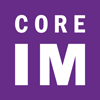Core IM
End-stage renal disease affects approximately 500,000 people in the United States. The optimal choice of renal replacement therapy is kidney transplant, as it improves quality of life, morbidity, and mortality. Many health care practitioners may, however, feel uncomfortable with post-kidney transplant care.
The goal of the episode is to educate health care professionals on transplant-specific care, including transplant medication, risk of kidney rejection, increased infection risk, and increased cancer risk. Join the Core IM team as they dive into common immunosuppression medications used for kidney transplant maintenance, approaches to a post-kidney transplant patient with acute kidney injury, recognizing the risk for transplant rejection, and identifying transplant-specific infection risk and cancer risk after kidney transplant.
Core IM invites you to the episode Post-Kidney Transplant: 5 Pearls Segment.
First, listen to the podcast. After listening, ACP members can take the CME/MOC quiz for free.
CME/MOC:
Up to 0.75
AMA PRA Category 1 Credits ™ and MOC Points
Expires August 16, 2026
active
Cost:
Free to Members
Format:
Podcasts and Audio Content
Product:
Core IM
Welcome to Core IM, a virtual medical community! Core IM strives to empower its colleagues of all levels and backgrounds with clinically applicable information as well as inspire curiosity and critical thinking. Core IM promotes its mission through podcasts and other multimodal dialogues. ACP has teamed up with Core IM to offer continuing medical education, available exclusively to ACP members by completing the CME/MOC quiz.

Pearl 1: Post-transplant immunosuppressive medications
- Maintenance immunosuppression
- Necessary to prevent rejection of the transplanted kidney
- Transplant regimens:
- Usually contain
- Tacrolimus
- Mycophenolate
- Sometimes contain
- Prednisone
- Newer medication:
- Belatacept
- Can only be given to EBV IgG positive patients
- Belatacept
- Usually contain
- Immunosuppressive Medications:
- Tacrolimus and cyclosporine:
- Calcineurin inhibitors: block IL-2 production in T-cells.
- Given every 12 hours
- Trough level is dosed just prior to the AM dose
- Goal - avoid toxicity and maintain a therapeutic window
- Especially neurotoxicity
- Goal - avoid toxicity and maintain a therapeutic window
- Side effects:
- Hypertension, tremors
- Tacrolimus - Hair loss, and new onset diabetes after transplant (NODAT)
- Cyclosporine - hirsutism and gingival hyperplasia
- Mycophenolic acid:
- Inhibits T and B lymphocyte proliferation by blocking purine synthesis
- Comes in two forms:
- Mycophenolate mofetil (CellCept)
- Original drug
- Can cause GI upset
- Enteric coated mycophenolate sodium (Myfortic)
- Less likely to cause GI upset
- Mycophenolate mofetil (CellCept)
- Side effects:
- Bone marrow suppression and gut toxicity
- Can be spaced out to three times daily to reduce the frequency of diarrhea
- Bone marrow suppression and gut toxicity
- Prednisone:
- Decreases neutrophil movement across capillaries
- Use according to local immunosuppressive protocols and underlying kidney disease
- Tacrolimus and cyclosporine:
Pearl 2: How do you do a good medication reconciliation? What do you need to be mindful about in post-renal transplant patients’ med rec?
- Transplant regimens can be complex!
- Understand what medications they take and when
- Assess for medication compliance
- Missing doses of immunosuppressive medication increases the risk of antibody mediated rejection
- Assess for medication compliance
-
- Assess for possible drug-drug interactions (not comprehensive)
- Medications that increase levels of tacrolimus:
- Calcium channel blockers
- Antifungals
- Macrolides
- Medications that decrease levels of tacrolimus:
- Anti-seizure medications
- Ciprofloxacin
- Medications that decrease levels of mycophenolate:
- Calcium carbonate
- Magnesium carbonate
- Proton-pump inhibitors
- Medications that increase levels of tacrolimus:
- Note: Clinical context can also affect the levels of tacrolimus
- Example: Diarrhea can affect tacrolimus trough levels variably in some patients!
- Faster GI transit → Less breakdown of tacrolimus by p-glycoprotein → higher trough levels
- Example: Diarrhea can affect tacrolimus trough levels variably in some patients!
- Assess for possible drug-drug interactions (not comprehensive)
- Understand what medications they take and when
Pearl 3: AKI in patients post-transplant
- Assess acute kidney injury in the transplant patient similar to how it is assessed in patients with native kidneys!
-
-
- Pre-renal
- Renal
- Post-renal.
-
- Pre-renal AKI post-transplant:
- Decreased oral intake → hypovolemia
- As they may be used to fluid restrictions from before the kidney transplant
- Decreased oral intake → hypovolemia
- Intrarenal AKI post-transplant:
- Tacrolimus can be nephrotoxic. Thus, we aim for trough levels within the therapeutic window
- In the first few months post-transplant
- Trough levels should be 10 to 12 ng/mL
- Approximately 6 to 12 months post transplant
- Trough levels should be around 5 to 7 ng/mL.
- For chronic transplant patients, the target can be individualized to:
- 4 to 6 ng/mL or
- 5 to 7 ng/mL or
- 6 to 8 ng/mL
- In the first few months post-transplant
- Acute rejection can also cause increased creatinine level (more in Pearl 5)
- Tacrolimus can be nephrotoxic. Thus, we aim for trough levels within the therapeutic window
- Post-renal AKI post-transplant:
- Assess causes using kidney ultrasound
- Place a Foley catheter if there is significant hydronephrosis
- Percutaneous nephrostomy may be necessary in cases of ureteral strictures
-
Pearl 4: Infections in patients post-transplant
- Increased risk infections post-transplant:
- CMV
- Serologic status is determined for both donor and recipient prior to transplant
- Highest risk of infection if donor is POSITIVE and recipient is NEGATIVE
- Appears in first year post-transplant
- Fever, diarrhea, malaise, leukopenia, and mild hepatitis
- Serologic status is determined for both donor and recipient prior to transplant
- EBV
- Serologic status is determined for both donor and recipient prior to transplant
- Highest risk risk of infection if donor is POSITIVE and recipient is NEGATIVE
- Presents as:
- Mononucleosis
- Fatigue, swollen glands, and pharyngitis
- Post-transplant lymphoproliferative disorder (PTLD)
- Fever, weight loss, malaise, and a new lymphadenopathy
- Mononucleosis
- Serologic status is determined for both donor and recipient prior to transplant
- BK virus
- Asymptomatic
- Screening is required to detect high viral load
- Can cause kidney inflammation and injury
- Asymptomatic
- CMV
- Measuring viral load with PCR is useful to determine whether or not a patient is presenting with active infection!
Pearl 5: Life with a Kidney Transplant
- Acute transplant rejection:
- Asymptomatic
- Frequent labs post-transplant to carefully monitor creatinine for rejection
- Requires biopsy for diagnosis of rejection
- Asymptomatic
- Increased risk of certain cancers, particularly those that are related to ones that are kept in check by the immune system:
- Non-melanoma skin cancer
- Annual dermatology appointments are recommended
- Oncogenic viruses
- EBV → lymphoma
- HPV → anogenital and oropharyngeal cancers
- Hepatitis B → hepatocellular carcinoma
- Hepatitis C → hepatocellular carcinoma
- Routine age-appropriate malignancy screening is important!
- Non-melanoma skin cancer
Contributors
Shreya Trivedi, MD, ACP Member – Author
Marcus Foo, MD, ACP Member - Author
Anjellica Chen, MD - Author
Karin True, MD - Expert
*Martha Pavlakis, MD - Expert
Reviewers
Pitchaphon Nissaisorkarn, MD
**Jean Francis, MD
Aditya Pawar, MD
*Dr. Pavlakis is a consultant for Memo Therapeutics, Merck, and Vertex Pharmaceuticals
**Dr. Francis is a consultant for Alexion Pharmaceuticals
Those named above, unless otherwise indicated, have no relevant financial relationships to disclose with ineligible companies whose primary business is producing, marketing, selling, re-selling, or distributing healthcare products used by or on patients. All relevant relationships have been mitigated.
Release Date: August 16, 2023
Expiration Date: August 15, 2026
CME Credit
This activity has been planned and implemented in accordance with the accreditation requirements and policies of the Accreditation Council for Continuing Medical Education (ACCME) through the joint providership of the American College of Physicians and Core IM. The American College of Physicians is accredited by the ACCME to provide continuing medical education for physicians.
The American College of Physicians designates this enduring material (podcast) for .75 AMA PRA Category 1 Credit™. Physicians should claim only the credit commensurate with the extent of their participation in the activity.
ABIM Maintenance of Certification (MOC) Points
Successful completion of this CME activity, which includes participation in the evaluation component, enables the participant to earn up to .75 medical knowledge MOC Point in the American Board of Internal Medicine’s (ABIM) Maintenance of Certification (MOC) program. Participants will earn MOC points equivalent to the amount of CME credits claimed for the activity. It is the CME activity provider’s responsibility to submit participant completion information to ACCME for the purpose of granting ABIM MOC credit.
How to Claim CME Credit and MOC Points
After listening to the podcast, complete a brief multiple-choice question quiz. To claim CME credit and MOC points you must achieve a minimum passing score of 66%. You may take the quiz multiple times to achieve a passing score.


